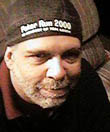|
|
 
|
|
Author
|
Topic: Fox Sprockets?
|
|
|
Bruce McGee
Phenomenal Film Handler

Posts: 1776
From: Asheville, NC USA... Nowhere in Particular.
Registered: Aug 1999
|
 posted 10-12-2001 11:14 AM
posted 10-12-2001 11:14 AM




Fox sprockets were an idea from Twentieth Century-Fox. When Cinemascope came out, there was not enough room on the 35mm film for the image and the four magnetic soundtracks. The solution was to use a smaller sprocket hole. I dont think that there was an optical soundtrack on these magnetic prints, either.I have a 50' piece of film with the mag tracks and 'Fox holes.' Unique, to say the least. No, it cant be run on standard sprockets, unfortunately.
| IP: Logged
|
|
John Pytlak
Film God

Posts: 9987
From: Rochester, NY 14650-1922
Registered: Jan 2000
|
 posted 10-12-2001 11:18 AM
posted 10-12-2001 11:18 AM





"Fox Sprockets" are the smaller "CS" perforations that were developed for use with the original "CinemaScope" system to provide the additional space needed for the magnetic stripes. The normal "KS" perforation is 0.1100 x 0.0780 inches, whereas the "CS" perforation is 0.0780 x 0.0730 inches. You MUST use sprockets made in accordance with standard SMPTE 242, having a tooth width of either 0.040 inches (Type S, or "Fox Tooth") or 0.072 inches (e.g., LaVezzi "VKF" sprocket). Wider sprocket teeth (e.g., LaVezzi "PosiTrol" sprocket) will severerly damage the perforations on print film perforated CS-1870. Likewise, your splicer needs to have the narrower "CS" registration pins, or the film will be damaged.Here is a link to information on Marty Hart's "American Widescreen Museum" website:
http://www.widescreenmuseum.com/widescreen/wingcs1.htm Here is information on the compatible "VKF" sprocket design:
http://www.lavezzi.com/PDFs/SprocketPDFs/VKFSprockets.pdf I assume your theatre is properly equipped to handle and play magnetic striped prints? Even if you play a later magnetic/optical track print on an optical reader, be sure you do not damage or accidently erase the magnetic tracks (degauss film path, be sure tracks aren't abraded, etc.). ------------------
John P. Pytlak, Senior Technical Specialist
Worldwide Technical Services, Entertainment Imaging
Research Labs, Building 69, Room 7525A
Rochester, New York, 14650-1922 USA
Tel: 716-477-5325 Cell: 716-781-4036 Fax: 716-722-7243
E-Mail: john.pytlak@kodak.com
Web site: http://www.kodak.com/go/motion
| IP: Logged
|
|
|
|
|
|
Steve Guttag
We forgot the crackers Gromit!!!

Posts: 12814
From: Annapolis, MD
Registered: Dec 1999
|
 posted 10-19-2001 08:03 PM
posted 10-19-2001 08:03 PM




Beware of using VKF sprockets with fox hole films. While the VKF sprocket was designed to work with CS perfs...they do not allow for hardly any shrinkage. Virtually all of the CS perf films I've seen as of late will not sit well on the VKF sprocket due to shrinkage. I now only recommend using CS sprockets if you plan to run CS perfs. As a cheater for a Simplex...thread your feed sprockets such that only one pad roller engages...that is, on the top sprocket use the first pad roller to keep the film off the sprocket an let it go though the second padroller (the one closest to the upper loop) normally. For the intermittent you are hosed though...if the film has shrunk enough, it will buckle in the gate area since it can't wrap the the tight intermittent sprocket. Also, if you haven't done so already, before running mag film, switch to delrin padrollers (no steel!). Steve ------------------
"Old projectionists never die, they just changeover!"
| IP: Logged
|
|
|
|
|
|
John Pytlak
Film God

Posts: 9987
From: Rochester, NY 14650-1922
Registered: Jan 2000
|
 posted 10-24-2001 07:22 AM
posted 10-24-2001 07:22 AM





Leo asked: "Also, do I remember correctly that 'fox hole' perforations have right-angled corners whereas conventional release print perfs have rounded corners?"For film perforated KS, standard SMPTE 139 specifies the radius of the perforation fillet (corners) to be 0.020 inches (0.51mm). For film perforated CS, standard SMPTE 102 specifies the radius of the perforation fillet (corners) to be 0.013 inches (0.33mm). ------------------
John P. Pytlak, Senior Technical Specialist
Worldwide Technical Services, Entertainment Imaging
Research Labs, Building 69, Room 7525A
Rochester, New York, 14650-1922 USA
Tel: 716-477-5325 Cell: 716-781-4036 Fax: 716-722-7243
E-Mail: john.pytlak@kodak.com
Web site: http://www.kodak.com/go/motion
| IP: Logged
|
|
|
|
|
|
Frank Angel
Film God

Posts: 5305
From: Brooklyn NY USA
Registered: Dec 1999
|
 posted 05-26-2002 03:49 PM
posted 05-26-2002 03:49 PM





Wow, Mark...THANK YOU! I thought perhaps I had imagined it -- I remember hearing the very same thing, that, dispite what first glance logic might say to the contrary, Foxholes ARE stronger and less suceptible to damage than standard sprocket holes. I've mentioned this to a number of film techies who insist that the opposite is true -- everyone seems to think they are weaker and more problematic. I seem to recall that the article was based on some extensive testing that was done at the time. I run LOTS of mag prints and the fox sprocket holes seem to show no more damage than standard -- and remember, any mag prints that you get now have to be decades old. And Joe B., that's our form. If you like, I can send you a blank to copy. We've in the process of changing a few things -- adding a space to indicate if the DTS discs were incluced with the print. If you don't run retrospective, you probably can get rid of some of the condition lines for the reels -- I settled on 12 reels because we routinely run MY FAIR LADY and it has 12 reels. You can probably use 8 and it would cover most current features. Email your mailing address to me and I'll send one out to you. Use Angel@BrooklynCenterCinema.com
| IP: Logged
|
|
|
|
All times are Central (GMT -6:00)
|
|
Powered by Infopop Corporation
UBB.classicTM
6.3.1.2
The Film-Tech Forums are designed for various members related to the cinema industry to express their opinions, viewpoints and testimonials on various products, services and events based upon speculation, personal knowledge and factual information through use, therefore all views represented here allow no liability upon the publishers of this web site and the owners of said views assume no liability for any ill will resulting from these postings. The posts made here are for educational as well as entertainment purposes and as such anyone viewing this portion of the website must accept these views as statements of the author of that opinion
and agrees to release the authors from any and all liability.
|

 Home
Home
 Products
Products
 Store
Store
 Forum
Forum
 Warehouse
Warehouse
 Contact Us
Contact Us




 Printer-friendly view of this topic
Printer-friendly view of this topic

















